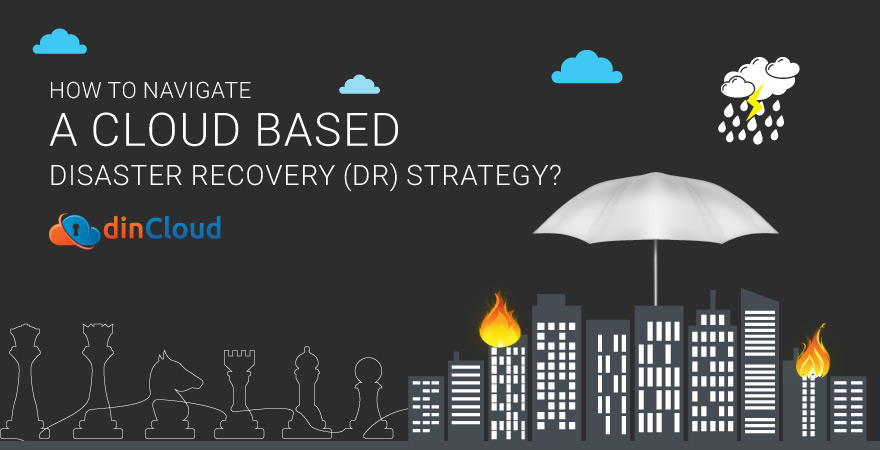Every business on the face of this planet is prone to disasters and disruptions. While no one can anticipate the exact time, nature or extent of a disruptive event, enterprises can surely establish some sort of a bottom line when it comes to dealing with disruptions. This very bottom line is known as Disaster Recovery (DR). Every organization in today’s technology driven world needs to have a robust DR plan in place. In today’s super competitive environment, unpreparedness for disasters means downtime. Downtime can be defined as the timespan when a business is incapacitated to serve its customers, due to any disruptive event. For some large technology companies, a downtime of just a few minutes can mean revenue losses equal to millions of dollars.  The impact of any disaster is not limited just to the financial aspect. The loss of reputation can have mid to long term implications on how customers perceive a business in the times to come. Over the years, traditional DR practices have proved costly and complex. Related: How dinCloud Solutions Measure Up With Your DR Needs?
The impact of any disaster is not limited just to the financial aspect. The loss of reputation can have mid to long term implications on how customers perceive a business in the times to come. Over the years, traditional DR practices have proved costly and complex. Related: How dinCloud Solutions Measure Up With Your DR Needs?
Salient Features of Legacy DR Methods
The traditional approach towards DR, if it even made it to the list of priorities, was focused around the replication of the entire infrastructure. You could consider the old DR methods to be a sort of “shadow infrastructure”, in which everything was replicated. This naturally made such DR mechanisms both complex and costly. These downsides were not limited to just the setup phase, rather costs and resource requirements of such DR mechanisms kept on ballooning, until a stage came when the plan had to be abandoned.
Steps to a Cloud DR Strategy
In this post, we will outline the steps that you need to undertake while adopting a cloud based DR strategy. Along each step, we will also be highlighting why a cloud based approach towards disaster recovery is a smart choice on many counts. Related: Your One Stop Guide to Disaster Recovery (DR)
Map Your Infrastructure
This is the starting point, and the most crucial phase of your DR plan. Each enterprise needs to map its entire infrastructure, helping it to determine the bare minimum applications and processes that need to be given priority in the DR strategy.
Identify Potential Risks
The risk profile of every enterprise will vary, depending on factors such as the industry, business model, nature of customers and the business environment itself. With this exercise, an enterprise will be able to identify the various threat vectors.
Visualize a DR Plan
Based on the first two steps, an enterprise needs to envision a DR plan for the future. This DR plan needs to give a lot of weightage to these two critical areas:-
1. Recovery Point Objective (RPO)
The RPO metric is in fact the data loss tolerance of an enterprise, based on which the frequency of the snapshots / backups that are created over the cloud will be determined. Depending on the business model, RTO could be a few minutes to a few days as well.
2. Recovery Time Objective (RTO)
Recovery Time Objective (RTO) is the metric which determines the timeframe for which the operations of a business can remain offline, after a disaster has struck. Similar to RPO, the RTO could also range between a few minutes to a few hours. One thing to remember here though, RTO is a very important metric is terms of how customers perceive the preparedness of an organization for disruptive events. On the flip side, the more strict your RPO and RTO, the more cloud resources would be required. Related: A Cloud First Disaster Recovery (DR) – The Way Forward
Choosing the Right Cloud DR Partner (DRaaS)
This is also a very crucial phase of the cloud DR journey. Some key factors to consider when choosing your Cloud Disaster Recovery as a Service (DRaaS) partner include data center footprint, security mechanisms, compliance posture, costs and customer support.
Putting a DR Plan in Place
The success of your cloud DR strategy hinges on the quality and homework done at the planning phase. Whenever a disaster or disruptive event strikes, it is mostly chaotic. So, every team member must be fully aware of the assigned role in any such eventuality.
Testing and Execution
In order to test the efficacy of your DR plan, you need to execute it in a mock / test environment. It is always a good practice to test your DR plan periodically, so that when something actually goes wrong, things move like clockwork. Related: How to build an affordable BC/DR strategy
Tweaking Your DR Plans
Based on the changing business environment, revision in your RTO or RPO, an enterprise needs to tweak its DR plans, and the underlying cloud resources that have been provisioned for such a plan. This will result in optimal utilization of the cloud resources used for DR.
Conclusion
Whether you view a Cloud based DR strategy from the perspective of cost, flexibility, resilience, scalability or compliance, it makes much more sense as compared to on-premise Disaster Recovery (DR) mechanisms. Choosing the right Cloud Service Provider (CSP) though, one that has the right set of resources in terms of infrastructure and experts, will play a decisive role in how much success you can achieve with a cloud centric DR strategy. If you are on the lookout for a reliable, cost efficient and resilient Disaster Recovery as a Service (DRaaS) partner, then dinCloud is the right choice for your enterprise on many counts.


